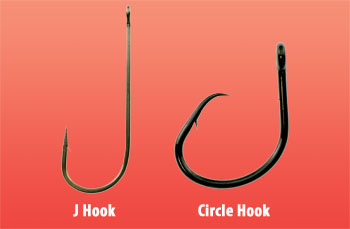A circle hook is a fishing hook designed so that the point is turned perpendicular to the shank to form a circular shape. The principal advantage to using circle hooks is that fish are almost never deep-hooked – research has found that circle hooks are more likely to hook a fish in the mouth rather than the gut, making them easier to remove and reducing harm to the fish.
The principle behind the hook is simple: after the hook has been swallowed the fisherman applies pressure to the line, pulling the hook out of the stomach. The actual curved shape keeps the hook from catching in the gut cavity or throat. Instead, the hook slides toward the point of resistance and embeds itself in the jaw or in the corner of the fish’s mouth.
Regulations
State and federal regulations require all commercial fishers and recreational anglers fishing for any reef fish species to have and use certain gear. Reef fish species include groupers, snappers, amberjacks, triggerfish, porgies, sea bass, hogfish and tilefish.
Regulations change often, so know the rules before you go.
Reef Fish Gear Rules | Federal Fishing Regulations | South Atlantic Fishery Management Council
Florida State Waters of the Gulf of Mexico Required Gear:
- Circle Hooks (Must be non-stainless steel and not offset) when using natural baits
- Dehooking Device
State Waters of the Atlantic Required Gear
- Dehooking Device
Note: In federal waters of the Atlantic north of 28° latitude, circle hooks are required when using hook and line gear and using natural baits
Other Areas
- On the Gulf of Mexico coast, anyone fishing for any species of reef fish in Gulf waters is required to use non-stainless steel circle hooks when fishing with natural bait. If you accidentally catch a Gulf reef fish on a J hook while using natural bait, you must release it.
- On the Atlantic coast, non-stainless steel circle hooks must be used when fishing for reef fish with hook and line gear and natural baits north of latitude 28°N in Atlantic federal waters (near Melbourne, Fla.).
- In Florida, it is required to use non-offset circle hooks when fishing with natural bait for reef fish in Gulf waters. Non-offset circle hooks are those in which the end of the hook is inline with the shank of the hook – rather than being angled sideways, away from the shank.
When to Use Them
- Circle hooks can be used on any species of fish caught on hook and line. They have been used by commercial fishermen for decades due to their ability to efficiently catch fish.
- Today both fresh and saltwater fishermen are using circle hooks to improve the survival of the fish that they catch and release.
How to Use Them
- Bottom Fishing: Bait the hook as usual. When a fish takes the bait, allow time for the fish to completely swallow the hook before steadily reeling in the line. Do not attempt to set the hook by sharply jerking the rod – this will pull the hook out of the fish’s mouth.
- Trolling: Attach to bait as for any other bait-trolling rig – often using a rubber band or waxed string to fasten the hook to the bait. This allows the hook to hang freely above the bait. Offshore fishermen are successfully trolling with their usual trolling rigs by simply replacing the old style J hooks with circle hooks.
- Live Bait: Hook live bait through a fleshy part of the fish. This allows the bait to swim freely and allows the hook to set when a fish strikes.
Hooking Technique
Don’t set the hook! Slowly and steadily reel in the slack in the line until the hook sets itself in the fish. This requires some patience and restraint… patience to make sure the fish has had time to swallow the bait… and restraint in the initial urge to forcefully set the hook.
Benefits of Non-stainless Steel Circle Hooks
- Non-stainless steel hooks will deteriorate over time.
- The hook sets itself when you reel in the line. This is great for inexperienced anglers and for deep-water fishing.


